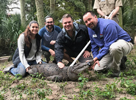Southeastern biologist discovers new species of crocodile
Thursday, September 26, 2019 
by: Tonya Lowentritt
NEW CROCODILE SPECIES DISCOVERED - Southeastern Louisiana University Assistant Professor of Biology Christopher Murray, along with colleague and former Southeastern classmate Caleb McMahan, discovered a new species of crocodile. Pictured, from left with the new species at St. Augustine Alligator Farm Zoological Park, are Jen Brueggen, park social media manager, McMahan, Murray, and John Brueggen, park director.
HAMMOND – It has been a while since anyone has found a new crocodile. Thanks
to the research of Southeastern Louisiana University Assistant Professor of Biology
Christopher Murray and his colleague and former Southeastern classmate Caleb McMahan,
that is no longer the case.
Southeastern Biological Sciences Department Head Christopher Beachy said that
in an average year, worldwide there are many species of reptile described; however,
most of these are snakes or lizards.
“Discovery of new species is not often a case of being in nature, seeing something
remarkable and exclaiming ‘Wow! This is an entirely new species.’” said Beachy. “New
species are described mostly when experts, like Dr. Murray, are involved. We’re especially
excited that this work began when Dr. Murray was studying to complete his master’s
degree at Southeastern. That this has come to completion now that he is a tenure-track
faculty member speaks to the quality of the training our graduate students receive.
It also speaks to the international reputation that many of our faculty have. We’re
very proud of that.”
Murray said the discovery is important because there are only about two dozen
described species of extant crocodilian.
“Adding to the diversity of a group that small, being such large charismatic
organisms with undiscovered species hiding right under our noses, is pretty rare,”
he said. “This also sheds light on biogeographic patterns of other organisms in the
area.”
As a student working on his master’s degree in biology at Southeastern, Murray
was reading several papers by the late Philip Hall, a crocodilian biologist who worked
in the U.S. on alligators and in Papua New Guinea on a species of crocodile called
the New Guinea Crocodile (Crocodylus navaeguineae).
“My thesis was on alligators in the U.S., but I recalled Philip Hall providing
ecological and morphological evidence that the New Guinea crocs on the north side
of the Central Highlands – a mountain range that runs east-west on the island of New
Guinea – were different than the ones on the south side of the mountain range,” Murray
explained. “For instance, they nested at different times of the year and had different
osteoderm – the little bones on their backs – patterns.”
At the time, Murray’s roommate and friend McMahan, now working for The Field
Museum in Chicago, was getting his master’s degree in evolutionary biology on fishes.
Murray shared the details of his thesis with McMahan, and over the next several years
they compiled data from New Guinea crocodile skulls from natural history museums,
including The Field Museum, the Smithsonian National Museum of Natural History, Museum
of Comparative Zoology at Harvard University, American Museum of Natural History,
Queensland Museum, Louisiana State University Museum of Natural Science, and Florida
Museum of Natural History.
“We took photos of the skulls and used a technique called geometric morphometrics
to analyze skull morphology,” Murray said. “These results when paired with published
genetic data and the ecological data originally provided, diagnosed the northern and
southern populations as being on independent evolutionary trajectories and warranted
the description of a new species.”
From there, Murray and McMahan took their findings to the St. Augustine Alligator
Farm Zoological Park in Florida to put their results to the test on live animals and
on the ethno-artifacts on display.
“We were pleasantly surprised that we could easily identify the two lineages
even when moving or artistically altered,” Murray said. “So Caleb and I decided to
name the species after Philip Hall, whose initial interests and observations spurred
the description itself.”
Named “Crocodylus halli,” the new species is a freshwater crocodile inhabiting
rivers and lagoons on the island of New Guinea, but Murray said more work is needed
assessing its ecology and conservation status.
“Now that we know the evolutionary history of these species, we need to re-inform
the conservation status of them given that the distribution has changed and conservation
threats are different in different areas,” he said. “Caleb and I would take on aspects
of that work, funding permitting.”






